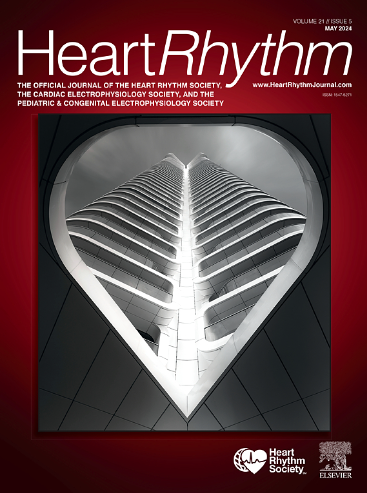Atrial flutter and sick sinus syndrome
IF 5.7
2区 医学
Q1 CARDIAC & CARDIOVASCULAR SYSTEMS
引用次数: 0
Abstract
Background
Sick sinus syndrome (SSS) is a common condition resulting in reduced quality of life, syncope, and permanent pacemaker (PPM) implantation, but predictors have not been elucidated. Whereas atrial arrhythmias are frequently associated with SSS, we hypothesized that atrial flutter (AFL) would strongly predict SSS, given shared relationships with right atrial and particularly crista terminalis fibrosis.
Objective
The study aimed to assess the impact of AFL on the occurrence of SSS and associated syncope and PPM implantation.
Methods
Health care databases were used to identify adults aged ≥18 years receiving hospital-based care in California in 2005–2019. International Classification of Diseases codes were used to identify diagnoses and procedures. Patients were classified on the basis of the presence of AFL and atrial fibrillation (AF). Cox proportional hazards models adjusting for demographics and comorbidities were employed.
Results
We included 29,357,609 individuals (54% female; mean age, 46 years), 101,243 with AFL alone, 1,674,680 with AF alone, and 284,547 with AF and AFL. After adjustment for age, sex, race and ethnicity, and comorbidities, AF, AFL, and both arrhythmias were each associated with increased risk of SSS and associated syncope and PPM implantation (all P < .001). In the population with AF, an additional AFL diagnosis conferred a higher risk for development of SSS (hazard ratio [HR],1.62; 95% confidence interval, 1.59–1.64), syncope (HR, 1.63; 1.54–1.72), and PPM implantation (HR, 1.74; 1.70–1.79).
Conclusion
AFL is associated with an increased risk of incident SSS and its adverse consequences, especially in patients with coexisting AF. AFL may be useful for risk stratification strategies to predict, to prevent, and to treat SSS.

心房扑动和病态窦性综合征
背景:病态窦房综合征(SSS)是一种常见疾病,会导致生活质量下降、晕厥和起搏器植入,但其预测因素尚未阐明。虽然房性心律失常经常与 SSS 相关,但我们假设,鉴于心房扑动(AFL)与右心房,尤其是嵴末纤维化的共同关系,AFL 将有力地预测 SSS:评估 AFL 对 SSS 的发生、相关晕厥和 PPM 植入的影响。方法:使用医疗数据库识别 2005-2019 年在加利福尼亚州接受医院治疗的年龄≥ 18 岁的成年人。采用 ICD 编码确定诊断和手术。根据是否存在 AFL 和心房颤动 (AF) 对患者进行分类。采用了调整人口统计学和合并疾病的 Cox 比例危险模型:我们纳入了 29,357,609 人(54% 为女性,平均年龄 46 岁),其中 101,243 人仅患有心房颤动,1,674,680 人仅患有心房颤动,284,547 人同时患有心房颤动和心房颤动。在对年龄、性别、种族和民族以及合并疾病进行调整后,房颤、心房颤动和两种心律失常均与 SSS 及相关晕厥和 PPM 植入风险的增加有关(均为 p):AFL 与发生 SSS 及其不良后果的风险增加有关,尤其是在合并房颤的患者中。AFL可能有助于预测、预防和治疗SSS的风险分层策略。
本文章由计算机程序翻译,如有差异,请以英文原文为准。
求助全文
约1分钟内获得全文
求助全文
来源期刊

Heart rhythm
医学-心血管系统
CiteScore
10.50
自引率
5.50%
发文量
1465
审稿时长
24 days
期刊介绍:
HeartRhythm, the official Journal of the Heart Rhythm Society and the Cardiac Electrophysiology Society, is a unique journal for fundamental discovery and clinical applicability.
HeartRhythm integrates the entire cardiac electrophysiology (EP) community from basic and clinical academic researchers, private practitioners, engineers, allied professionals, industry, and trainees, all of whom are vital and interdependent members of our EP community.
The Heart Rhythm Society is the international leader in science, education, and advocacy for cardiac arrhythmia professionals and patients, and the primary information resource on heart rhythm disorders. Its mission is to improve the care of patients by promoting research, education, and optimal health care policies and standards.
 求助内容:
求助内容: 应助结果提醒方式:
应助结果提醒方式:


